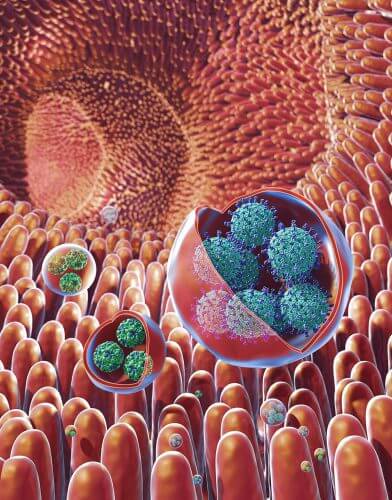An exciting innovation in virology - at least two types of viruses RNA, Noroviruses and Rotaviruses, which cause infectious and life-threatening intestinal diseases, infect their target cells when they are in aggregates of membrane-enveloped 10-6 viruses

Written by: Dr. Dror Bar-Nir, the Open University and the owner of the blog - Bacteria, viruses and other "vegetables"
When it comes to viruses, which infect target cells as part of the process of causing the disease, the familiar concept to all of us is that of a single virus wandering in its environment, until its adhesins happen to meet receptors of the host cell. Only then does the process of entry of the virus into the host cell begin - where many offspring of the same virus are produced, each wrapped individually in a piece of membrane of the host cell in which envelope proteins of the virus were inserted on their way out of the cell (dead or alive, depending on the virus and the cell), and each The process starts over.
When the single virus wanders in its environment, in the various spaces inside the human body or any other animal reservoir, it is exposed to the various messengers of the immune system - cells, antibodies and others, which may trap it or neutralize it, thus preventing it from meeting the target cell.
Researchers from the United States National Institutes of Health (NIH) led by Altan-Bonnet published in August 2018 in the journal Cell host & Microbe a discovery that changes this concept. They studied two well-known intestinal viruses, which are highly contagious and therefore spread rapidly in densely populated places - the rotavirus and the norovirus - which cause life-threatening intestinal diseases - the first in children who are infected from each other mainly in day care centers and kindergartens, and the second in adults and those with compromised immune systems - Mainly in cruise ships and residences for the elderly. It is important to note that there is currently a vaccine against rotavirus that significantly reduces hospitalization morbidity and mortality. A new vaccine was recently developed against the noroviruses, which we hope will be included in routine vaccines soon.
The researchers found that the initial, extracellular phase of these viruses is multiviral: it turns out that these viruses do not leave their host cells singly, like most other viruses, but in clusters, wrapped in a membranous bubble that originates from the cell from which they came out, which hides them, and thus protects them, from the immune system. This is mainly how they are also found in the source through which they infect new hosts, in feces.
The researchers compared the infection capacity of experimental animals in clusters of viruses, compared to individual viruses, and found that the infection of the clusters was significantly effective.
The survival advantage
The researchers believe that cluster infection - especially when it comes to RNA viruses, has a survival - evolutionary advantage: the viral enzymes that replicate RNA, unlike the cellular enzymes that replicate DNA, lack the ability to proofread. Therefore, many of the descendants of these viruses have mutations that do not allow the infection cycle of the virus. When it comes to a cluster, and not a single virus, the chance also increases that at least one of the viruses in the cluster is normal, and the genetic information to reproduce in the shelter is intact. But in addition, even if all the viruses are abnormal, there is still the possibility of complementation (completion) between the different genomes, so that the host cell will have all the genetic information for replicating normal viral offspring.
The phenomenon probably characterizes other intestinal viruses, such as the polio viruses, and possibly respiratory viruses as well. But this still needs to be tested.
Will this discovery help the development of antiviral drugs in the future? time will tell.
Summary of the original article:
More of the topic in Hayadan:
